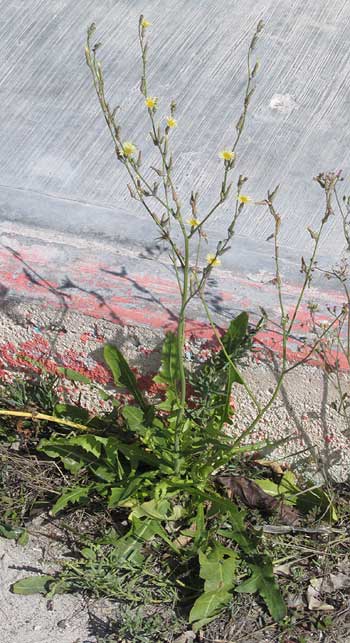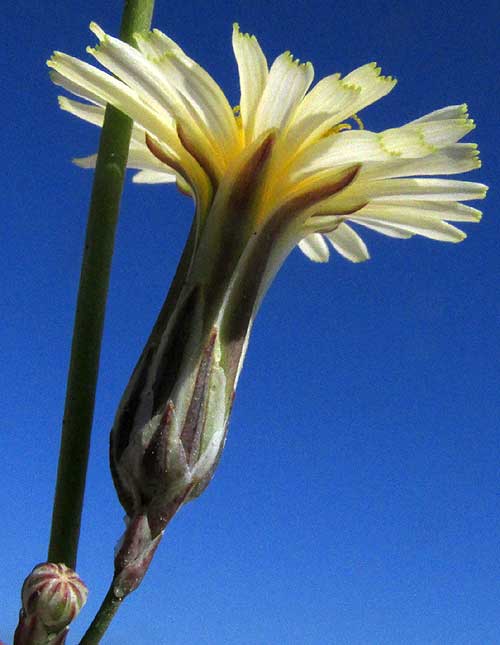Excerpts from Jim Conrad's
Naturalist Newsletter
from the February 15, 2015 Newsletter issued from Río Lagartos, on the Yucatan Peninsula's northern coast (~N21.60°, ~W88.16°), Yucatán state, MÉXICO
BITTER LETTUCE

At the edge of the sidewalk beside the seawall along Río Lagartos's broad, pleasant-to-walk, peripheral avenue called the Malecón, there was a yellow-flowering weed that was so obviously one of the several ubiquitous and cosmopolitan "prickly lettuces" of the Composite or Sunflower Flower genus Lactuca, that the first few times I passed it by I didn't even tarry to give it a good look. However, eventually curiosity kicked in. Since here on the Yucatan's northern coast we have so many endemics and otherwise curious species, might not this plain-looking little plant actually be something interesting masquerading as something humdrum? I decided to "do the botany." You can see its "habitat picture" above.
Its flower head, consisting only of ray flowers, like a dandelion, was a typical prickly lettuce flower head, and a pleasure to contemplate against the Yucatan's deep blue sky, as shown below:

The ray flowers with their wishbone-shaped style arms spectacularly burst outward from their involucre, as seen in a top view, below:

Some of the plants heads already had matured, producing cypsela-type fruits topped with "white parachutes," their "pappi," designed for wind dispersal, as shown below:

The plant's Dandelion-like leaves cluster toward the base, but a few leaves do arise very low on the stems -- not all rising from the ground as with Dandelions -- as seen below:

When the plant was keyed out in the online Flora of North America, the key surprised me by not leading directly to the prickly-lettuce genus Lactuca. It said that the plant was a Launea, a genus I'd never heard of. Only one species of Launea is described in the Flora of North America, LAUNAEA INTYBACEA, and that species also is listed for the Yucatan. And that's what we have, an introduced weed from Africa, now invasive worldwide in tropical and subtropical disturbed areas such as roadsides and agricultural lands, but also in coastal strand vegetation. Sometimes it's called Bitter Lettuce, like several other species.
So, this ordinary weed was worth looking at, and it wasn't a regular prickly lettuce at all. But, the question arises, "Sharing so many features with prickly lettuce species, why isn't this also a prickly lettuce -- a member of the genus Lactuca?" When the matter was looked into, it became clear that over the years taxonomists have been uncertain as to how to deal with this species. In fact, even nowadays, about half the big, prestigious web sites dealing with plants do indeed regard it as a Lactuca. In the past the species has drifted not only between Launea and Lactuca, but also it's visited the sow-thistle genus Sonchus, as well as the murky genera Brachyramphus, Cicerbita and Phoenixopus. To me it's a Lactuca despite what Flora of North America says.
Anyway, Bitter Lettuce is a perennial that keeps producing new rosettes of leaves at the plant's bottom year after year, sending up new shoots from the root for several years, probably at the beginning of each new rainy season.
Lettuce found in salads is a member of the genus Lactuca and over the years we've feasted on several prickly lettuce species, so it's not surprising that Bitter Lettuce leaves are edible, though bitter. Green Deane at his EatTheWeeds.Com website says of it, "Don't be surprised if you have to boil leaves 40 minutes or so in a lot of water to make it edible." Bitter Lettuce is also eaten by farm animals.
The name Launea intybacea struck me as a little exotic, so I looked up where it comes from. Probably the name Launea honors French botanist Jean Claude Michel Mordant de Launay, who lived from 1750-1816. He was a lawyer-turned-naturalist who as librarian at France's Museum of Natural History wrote books on gardening. The name intybacea is Latin for closely related and delicious Endive/Chicory, and that word came into Latin from the Egyptian word tybi, which means January, because that's the month when ancient Egyptians customarily ate Endive.
When you're walking along the Malecón with your mind wandering, wondering... there's just no telling where your thoughts will lead you.